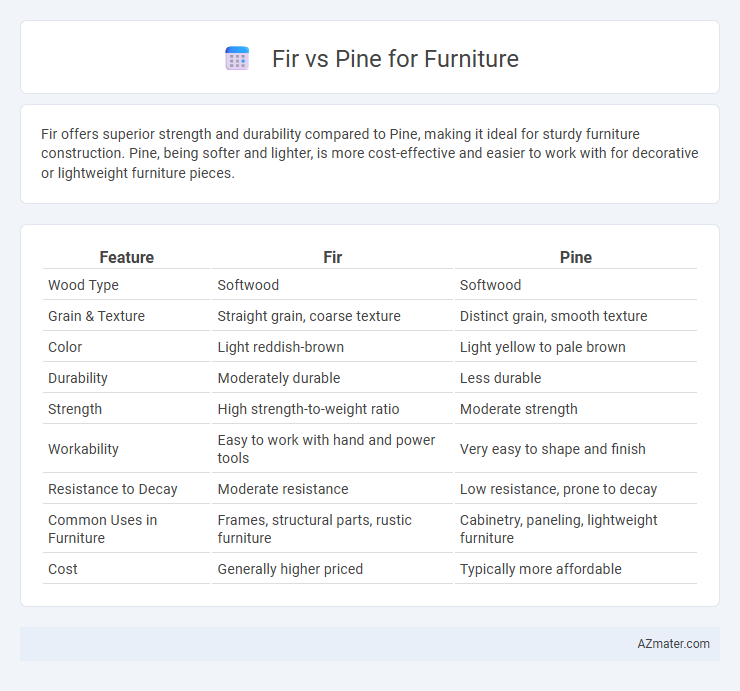Fir offers superior strength and durability compared to Pine, making it ideal for sturdy furniture construction. Pine, being softer and lighter, is more cost-effective and easier to work with for decorative or lightweight furniture pieces.
Table of Comparison
| Feature | Fir | Pine |
|---|---|---|
| Wood Type | Softwood | Softwood |
| Grain & Texture | Straight grain, coarse texture | Distinct grain, smooth texture |
| Color | Light reddish-brown | Light yellow to pale brown |
| Durability | Moderately durable | Less durable |
| Strength | High strength-to-weight ratio | Moderate strength |
| Workability | Easy to work with hand and power tools | Very easy to shape and finish |
| Resistance to Decay | Moderate resistance | Low resistance, prone to decay |
| Common Uses in Furniture | Frames, structural parts, rustic furniture | Cabinetry, paneling, lightweight furniture |
| Cost | Generally higher priced | Typically more affordable |
Introduction to Fir and Pine for Furniture
Fir and pine are popular softwoods used in furniture making, each offering distinct characteristics that influence durability and appearance. Fir, known for its strength and fine, straight grain, is often favored for structural furniture pieces requiring robustness. Pine features a lighter weight and softer texture with prominent knots, lending a rustic charm ideal for casual or country-style furniture designs.
Key Differences Between Fir and Pine Wood
Fir wood features a straight grain and a reddish-brown hue, offering higher strength and durability compared to Pine, which typically has a lighter color with prominent knots. Pine wood is softer and easier to work with, making it ideal for furniture requiring intricate carving, whereas Fir's hardness provides better resistance to dents and wear. Moisture resistance in Fir is generally superior, contributing to its suitability for both indoor and some outdoor furniture applications.
Appearance: Grain, Color, and Texture
Fir wood features a straight, pronounced grain with a reddish-brown hue that can deepen over time, offering a rustic and warm aesthetic ideal for furniture. Pine typically exhibits a lighter, creamy-yellow color with a prominent, knotty grain pattern that adds character and charm to furniture pieces. The texture of fir is generally coarse and firm, while pine is softer and smoother, influencing the finish and durability of the final product.
Durability and Strength Comparison
Fir wood offers moderate durability and strength, making it suitable for indoor furniture that doesn't require heavy load-bearing capacity, while pine tends to be softer and less durable but easier to work with for intricate designs. Both woods have a Janka hardness rating below hardwoods, with Douglas fir around 660 and pine species varying from 380 to 870, highlighting fir's generally superior strength. Fir is more resistant to wear and dents, which contributes to its longer lifespan in furniture applications compared to most pine varieties.
Workability and Ease of Use
Fir wood is known for its excellent workability, offering a fine, straight grain that makes it easy to cut, plane, and sand, ideal for furniture requiring precise detailing. Pine, softer and more pliable, allows for quick shaping and carving, but its knotty texture can challenge smooth finishes and durability in high-wear pieces. Both woods are favorable for beginner furniture makers, with fir providing a sturdier, more consistent surface, while pine delivers greater flexibility and affordability.
Cost and Availability of Fir vs Pine
Fir wood generally costs more than pine due to its greater durability and strength, making it a preferred choice for high-quality furniture. Pine is widely available and more affordable, often used for budget-friendly furniture and projects requiring easier workability. Availability of pine is higher in most regions, while fir may be limited depending on location, influencing cost and access for furniture manufacturing.
Environmental Impact and Sustainability
Fir wood, often harvested from fast-growing Douglas fir trees, offers a sustainable option for furniture due to its rapid regeneration and lower carbon footprint compared to slower-growing species. Pine furniture is also environmentally friendly, especially when sourced from responsibly managed plantations that promote biodiversity and reduce deforestation. Both fir and pine contribute to sustainable forestry practices, but fir's higher density provides greater durability, potentially extending furniture lifespan and reducing resource consumption over time.
Best Uses for Fir in Furniture Making
Fir wood, known for its strength and straight grain, is ideal for furniture pieces requiring durability and structural stability such as tables, chairs, and bed frames. Its light color and fine texture make it an excellent choice for staining and finishing, enhancing aesthetic appeal while maintaining affordability. Fir's resistance to warping and ease of working with hand or power tools contribute to its popularity in both rustic and modern furniture designs.
Best Uses for Pine in Furniture Making
Pine wood is widely favored in furniture making for its affordability, lightweight nature, and ease of working with hand and power tools. Its soft texture allows for detailed carving and shaping, making it ideal for rustic or country-style furniture pieces. Pine's natural resistance to shrinking and warping ensures durability in indoor furniture such as bookshelves, dressers, and child-friendly items.
Choosing Between Fir and Pine: Which is Right for Your Furniture Project?
Fir offers superior strength and durability, making it ideal for furniture that requires long-lasting support and structural integrity, while pine's softer texture and lighter weight provide easier workability and a more rustic, natural appearance. Pine's natural knots and resin contribute to its charm but may require extra finishing care to avoid wear, whereas fir's consistent grain and fewer knots yield a smooth, polished look suited for modern designs. Selecting between fir and pine depends on the furniture's intended use, desired aesthetic, and the balance between strength and ease of customization.

Infographic: Fir vs Pine for Furniture
 azmater.com
azmater.com